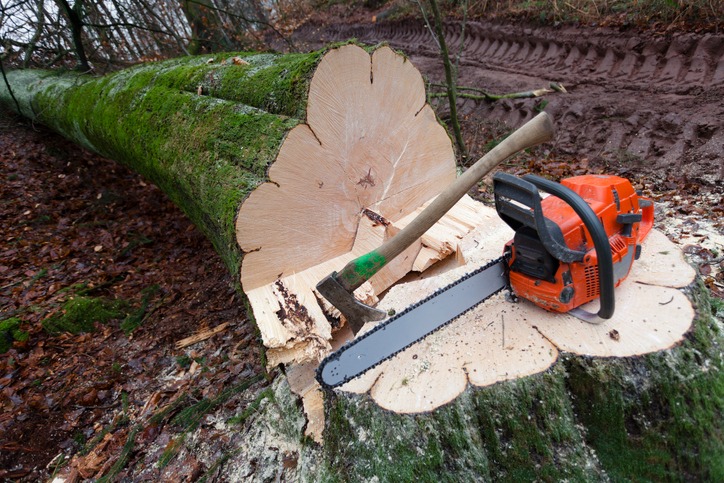TREE EDUCATION

Trees are masterpieces of Mother Nature, protective forces along your property, and they exist and grow alongside you and your family. Whether a tree on your property was established long before you moved into your home or you planted the tree years ago, our trees mean a lot to us. So, if you have to remove a tree from your landscape, it can be a difficult experience. But how will you know when it's time for Gainesville tree removal? Our arborists offer specialized care for young and mature trees and provide tree restoration and preservation for clients with properties throughout North Central Florida.
We do everything we can to keep trees healthy, but in some cases, they may need to be removed. Here, our Gainesville arborist discusses the top eight signs it's time for tree removal. The best way to determine if you need tree removal is with the help of a certified arborist, like those with SkyFrog Tree Service. Contact us today to schedule arborist services in Gainesville!
Storm damage is one of the most common reasons a tree may need to be removed. North Central Florida receives its fair share of seasonal storms and hurricanes, with high winds and significant amounts of rainfall. These storms can pose a hazard to your home or business, particularly if your property has unhealthy or damaged trees and fallen limbs. SkyFrog Tree Service offers 24/7 emergency tree and limb removal for storm damaged trees, restoring your property to a safe condition, free from hazardous debris.
Trees with rotting roots or root rot aren't always beyond recovery. In some cases, comprehensive, professional treatment can remedy the rot and restore your tree to a healthy, sustainable condition. However, for trees with an overwhelming amount of decay or for those that pose a safety risk, tree removal in Gainesville, FL, may be required. Identifying signs of decaying roots can be difficult, making this a job best left to an arborist. Symptoms of root rot include poor growth, fungus at the roots, discolored leaves, poor growth, and branch issues.
If you observe your tree and spot mushrooms growing at its base, you should be concerned. The presence of fungus on a tree can be a common sign indicating disease. Some fungal tree diseases can be treated, and with treatment from a certified arborist, it may be restored to its original, healthy state. However, other trees may not respond to disease treatment. Additionally, trees with significant disease can spread the infection to surrounding trees and plants. Even old stumps can spread disease, requiring stump grinding to remediate disease from your property.
When a tree develops problems, it can often be difficult for property owners to decide if and when to remove it. Dead or dying trees in natural areas that don't pose a danger to properties may be allowed to remain in place without human intervention. But dying or dead trees on residential and commercial properties that do pose a danger to animals, humans, and structures may indeed require Gainesville, FL, tree removal. Telltale signs of a dead or dying tree include dead branches, no leaves or buds during spring or summer, significant trunk leaning, disease, or signs of insect infestation.
Trees that grow vertically are often less of a hazard than those with a non-vertical or leaning growth pattern. A leaning tree is among the most significant signs indicating it is at risk of falling. If a previously non-leaning tree on your property now appears to lean, the new lean may point to signs of tree death, as the ground beneath the tree no longer supports the roots. Or it can point to damaged roots, which cannot hold the tree upright any longer. The best way to determine if a leaning tree requires tree removal service, call our arborists for an expert opinion.
Trees grow in a vast range of interesting manners, providing the perfect platforms to climb and play and an ideal habitat for local animals and pollinators. Trees often have features unique to them, which are typically harmless and simply add to their character. Yet, a hollow hole in the trunk of a tree can indicate decay. If a tree limb falls from the tree, take a look at the tree to see if a hollow area is exposed. You might notice local wildlife making their homes in the cavity. There's no need to unnecessarily disturb an owl, squirrel, or another animal by cutting down their home, particularly without a second opinion. Call our arborist to determine whether the tree needs to be removed.
Would a healthy tree ever require removal? Under what circumstances would tree and stump removal be appropriate? Unfortunately, in some cases, even a healthy tree needs to be removed. If a healthy tree is located too close to your home, business, or another structure, a tree expert may recommend removal in order to remediate the potential hazard of the tree destabilizing the foundation or crashing through the roof. Removal may also be recommended if a tree is located in too close proximity to powerlines.
Another potential cause for tree removal is if the tree is an invasive species that actively causes harm to surrounding native plant species. Non-Florida-native trees can grow much quicker than native trees, preventing trees and plants surrounding the non-native tree from getting adequate sunlight, nutrients, and irrigation. Local wildlife and pollinators depend on native trees for shelter and food, and they can suffer as a result of invasive species taking over. If you're unsure if you have invasive trees on your property, an arborist in Gainesville, FL, at SkyFrog Tree Service can help! Contact us today to schedule a tree assessment!